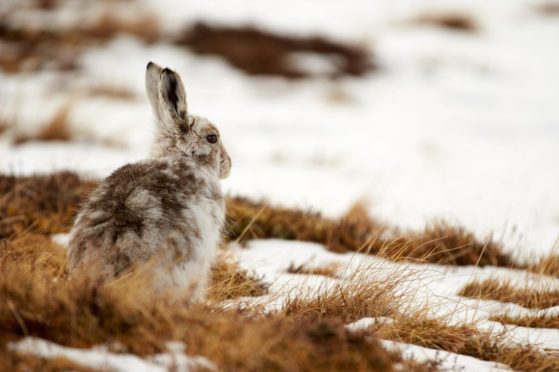
They call him the Hare Whisperer. Author and photographer Andy Howard has a special understanding of the little-known species, which has allowed him to capture the elusive creatures in astonishing detail.
Here, he tells Sally McDonald The Honest Truth about the mountain hare.
Why did you write this book?
Until recently, mountain hares have been under-appreciated by the public. Even hillwalkers tend to see them as formless fluffy things of only adjacent interest as they climb to the summit cairn.
I wanted the book to reveal their individuality, to frame and present their inherent beauty and comic charm. I feel it is essential to the security of the species and to our own positive relationship with nature.
Where did your research take you?
Living close to the Cairngorms National Park I was spoiled for opportunity. Many hours were spent in the higher reaches of the mountains, and more again on the lower hills and moors south of Inverness.
What was your most surprising discovery?
My own patience in the presence of mountain hares. I learned that, by biding my time, and allowing them come to me, I would get the best images. I also discovered that when I talk to them in soft tones they relax and behave quite naturally in my presence, which is how I got my nickname, “The Hare Whisperer”.
Photographing hares in winter surely can’t be easy?
One day stands out in my memory. Over a metre of snow had fallen and the walk up the mountain was laborious.
Near the top was a location which was home to at least two dozen mountain hares. However, none could be seen. I eventually spotted a newly dug mound of snow and realised they were tucked into deep tunnels they had been excavating throughout the storm. Only the very tips of their noses could be seen above the fresh snowfall. I built a little wall of snow as a makeshift hide. Soon, the hares were happily moving around with no suspicion of me or my camera.
The images captured perfectly represent what a mountain hare endures on a brutally cold winter’s day.
How long have there been mountain hares in Scotland?
They are indigenous to our islands, present since the end of the last ice age more than 10,000 years ago.
Their more numerous cousin, the brown hare, was introduced much more recently.
Why is the species important?
As an indicator species they signify a healthy ecosystem. They are an essential part of a fragile and marginal food chain, the leverets being prey to stoats and other group predators and, of course, the adults make up a large part of the diet of the golden eagle.
What are the risks to the species?
Climate change, and not only in the sense of loss of habitat. More detrimental still are the mild and wet winters that now prevail and cause high levels of mortality. Hares have evolved for snow and deep cold. Evolution works against them in the spring, when their white pelage stands out on moorlands bereft of snow and eagles are hunting to feed their hungry chicks.
How can we protect them?
In the short term the Scottish Government has passed legislation to protect them from non-licensed culling. But we must slow down or, better still, halt global warming.
What would you like readers to take from this book?
To understand that these stunning creatures are our national treasures. It will be an incredible loss to our children and our children’s children if we lose them.
On a lighter note, mountain hares are like us in that they have individual characters. Some are timid while others will accept and enjoy, the company of a human.
I would wish my images and stories remain in readers’ hearts for a very long time.
The Secret Life Of The Mountain Hare by Andy Howard, published by Sandstone Press, is out now

Enjoy the convenience of having The Sunday Post delivered as a digital ePaper straight to your smartphone, tablet or computer.
Subscribe for only £5.49 a month and enjoy all the benefits of the printed paper as a digital replica.
Subscribe